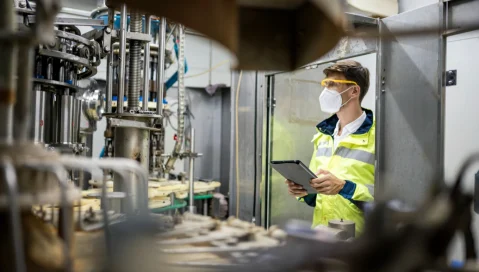How Food and Beverage Businesses Can Mitigate the Risk of Demand Disruption
How Food and Beverage Businesses Can Mitigate the Risk of Demand Disruption
How Food and Beverage Businesses Can Mitigate the Risk of Demand Disruption
15 Juil 2021
Jack Payne
For the food and beverage industry, the COVID-19 pandemic demonstrated a truth that will be of great significance in the coming decades: Drastic shifts in demand aren’t just a possibility, but instead a reality, and the balance between retail and restaurant revenue most likely will not remain fixed going forward.
Between February and April of 2020, the percentage of dollars spent on food at home (grocery and delivery) jumped to 68% from 50%, while the percentage spent on food away from home (restaurants and other foodservice outlets) dropped a full 20%. This relatively quick upheaval of the status quo forced food and beverage businesses to scramble and change their focus to suit the new pattern of consumption.
Some companies were better equipped to adapt to the new scenario as a result of their sub-industry or sector already having a retail focus. Nevertheless, nearly every food and beverage operation felt the impacts of the swing making the need to enhance preparedness at the organizational level quite clear. But considering the condensed timeframe of events and the massive scope of many leading brands, not all businesses have had the chance to make the necessary adjustments, and this will therefore remain a priority going forward.
Here, we’ll look at some of the strategies your food and beverage company can use to mitigate the risks a dramatic shift in demand can pose. We’ll also cover the ways in which technology can better equip your operations to handle other shifts in the industry landscape, whether small or big.
Key Risk Mitigation Strategies
What can your business do now to be more resilient to sudden drop-offs and spikes in demand? First, it’s a good idea to examine a few of the lessons learned over the past year-and-a-half and evaluate their future applications.
Emphasizing Longer Shelf Life
Take, for instance, the surge in sales of frozen food early in 2020 that amounted to a 40% increase by March 2020. This, coupled with considerable gains in canned soups and snack foods, shows the need for food and beverage manufacturers to ensure that their suite of offerings with longer shelf lives and greater convenience is robust and designed to please even the pickiest customers.
Premiumization
The increasing prevalence and popularity of premium and even customizable products—known as “premiumization”—is another trend worth examining. By giving stressed consumers the ability to treat themselves with fancier, higher-quality baked goods, confections, meat, seafood, beverages and more, businesses were able to recoup some of the lost profits from restaurant channels.
Direct-to-Consumer Sales
Direct-to-consumer and online sales models are also going to continue to be vital. Food and beverage became the largest online consumer packaged goods (CPG) segment in 2020, overtaking health and beauty by jumping to 44% of all sales. While this was due at least in part to the many lockdown and stay-at-home orders issued, the convenience of these options will be a major differentiator for brands wanting to maintain their presence, as 44% of global consumers anticipate making fewer trips to food service outlets even post-pandemic.
Meal Kits and Bundles
Meanwhile, meal kits and bundles will be yet another area of interest. With 47% of consumers experiencing difficulty in coming up with meal ideas and 46% preferring to plan and shop for several days’ worth of meals at a time, offering complete packages with ingredients and directions included and the option to purchase several of those kits at once will be highly attractive to the time-pressured and decision-fatigued public.
Adjusting the “Just-in-Time” Model
Still another reality of the pandemic-era retail marketplace that will inform approaches going forward is the fragility of the food supply chain and the flaws of the just-in-time (JIT) delivery. While the product shortages at stores were to some degree a result of erratic buyer behavior—including stockpiling necessities like toilet paper unnecessarily—the nature of the JIT model will likely need to be tweaked, especially for high-risk items.
Seeking Alternative Outlets
Finally, the importance of having alternative outlets for products should one revenue segment suffer from shutdowns—as restaurants did in 2020—can’t be overstated. Your goods likely have a limited shelf life, and you want to avoid wasting that which you can’t sell. Food banks and government programs can make for viable channels in periods of disruption.
The Advantages of Advanced Technology
Of course, being prepared for a shift in revenue streams relies on offering the right products via the right channels, but there are also ways you can internally increase your food and beverage business’s resiliency in the face of uncertainty. Implementing new technologies—namely enterprise resource planning (ERP) solutions—can be the key in unlocking greater reliability and agility.
One function of purpose-built ERP systems that is crucial on this front is demand planning. You need reliable projections in order to meet consumer demand while also minimizing the amount of product left unsold. The best platforms, like our industry-specific food and beverage solution, Aptean Food & Beverage ERP, use advanced analytics and historical data along with other environmental factors to produce dependably accurate estimations for future business.
When you’re trying to navigate the rough waters of a market disruption while retaining your competitive advantage, you need true operational flexibility. A food and beverage industry-specific ERP can provide this differentiating factor. You gain complete control over recipe and formula management, allowing you to tinker with your product lineup to find a new offering that suits the changing landscape. And the cross-department integration grant you visibility of all relevant information—supercharging the speed and effectiveness of your decision-making.
Cloud deployment and remote access options are also crucial, as we saw a huge adjustment in operations with more people working from home in 2020 than ever before. While facilities will likely open back up to at least partial capacity as the COVID-19 vaccine continues to be rolled out, it’s estimated that 36 million U.S. workers will be fully remote by 2025. The on-the-go nature of modern professionals will certainly affect your workforce. So making the right technology decisions now will help you safeguard your business in the future.
Carving Out the Future with Confidence
The food and beverage industry has seen more change over the past year than many even thought possible for such a large and fundamental piece of the business landscape. That just goes to show that resting on your laurels and trusting to the “way it’s always been done” may not cut it going forward.
Critically assessing your products and their marketability in various applications and scenarios would be a prudent step to take at this point, as the “new normal” is being defined right here, right now. At the same time, you need to fully modernize your organization from top to bottom. Truly embracing your digital transformation, will ensure you’ve got the right tools to act quickly and effectively in the face of changes.
We can help you get up to speed with the latest developments in food and beverage software solutions. Contact us today to hear more about how we can help prepare your business for the next big shift in food and beverage demand.
Prêt à transformer votre entreprise ?
Nous avons les solutions ERP spécialisées dont vous avez besoin pour relever les défis de votre secteur.



